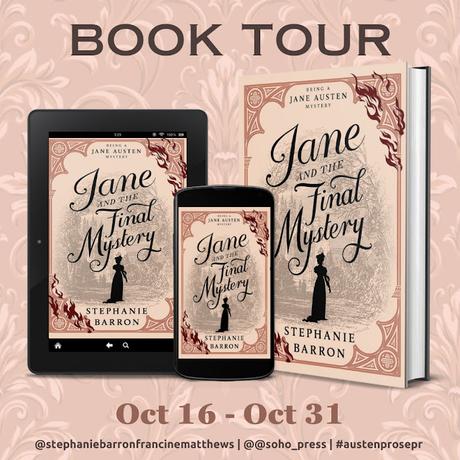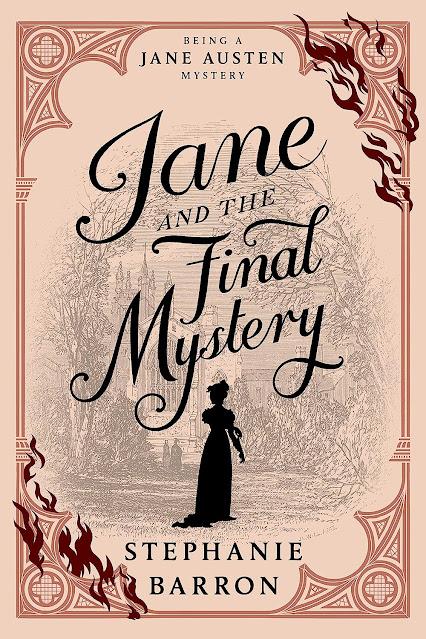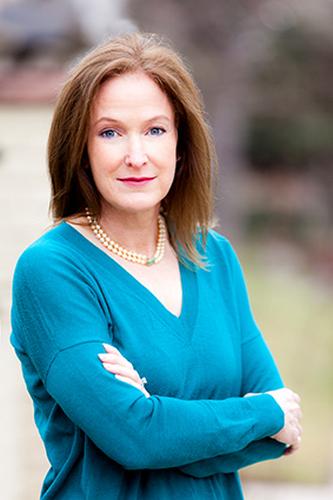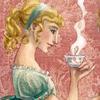
Dear fellow Jane Austen enthusiasts and mystery lovers,
It's a delightful honor to kick off the blog tour for Stephanie Barron's latest novel, "JANE AND THE FINAL MYSTERY." As we gather here, ready to embark on a literary journey that promises both intrigue and bittersweet reflection, we have the unique privilege of delving into the mind of one of the world's most beloved authors, Jane Austen, as envisioned by the talented Stephanie Barron.
In this beautifully crafted book, Barron invites us to step into the final days of Jane Austen's life, where her indomitable spirit and unquenchable curiosity drive her to solve a mystery that hits close to home. Based on true events from Austen's life, this novel promises to be a fitting tribute to the woman whose wit and wisdom continue to captivate readers around the globe.
But the excitement doesn't stop here. In an exclusive treat for our readers, we have the privilege of a one-on-one interview with the brilliant author herself, Stephanie Barron.
So, grab your favorite tea, settle into a cozy spot, and let the adventure begin as we step into the world of Stephanie Barron's Jane Austen mysteries. It's a journey that promises to be as captivating and enchanting as the works of the great Austen herself.
Without further ado, let's dive into our interview with Stephanie Barron and discover the secrets behind the mysteries that continue to keep us turning the pages.
Stay tuned, dear readers, for a delightful exploration of literature, history, and the enduring legacy of Jane Austen. My review of the book is coming soon!
Happy reading!
Maria Grazia💕
INTERVIEW WITH STEPHANIE BARRON
Jane and the Final Mystery is your fifteenth and concluding novel in the Being the Jane Austen Mystery series. Can you share your inspiration for the story?
As with all the Jane mysteries, the plotting is multi-layered and drawn from the particular context of Jane’s life, her extended family’s concerns, and the greater context of British society. I’ve brought Jane over the course of fifteen novels to her final months—she died in Winchester in July 1817—but I had no desire to set Final Mystery around her deathbed. The possibility of using Winchester as a setting, however, intrigued me. I knew that all of Edward Austen Knight’s sons were educated at Winchester College, the oldest boys’ public school in England, along with James’s son Edward, who had recently gone up to Oxford but spent a good part of his holidays in 1817 with his aunt Jane at Chawton Cottage. I decided to send Jane and Edward to Winchester over Easter Week, 1817, when Edward would have been down from Oxford and the rest of the Austen family were gathered in Berkshire with Aunt Jane Perrot following the death of Mrs. Austen’s brother, James Leigh-Perrot, in late March.
The events take place in Winchester, Englandin 1817 when Jane investigates the murder of a Winchester College schoolboy. Can you share who the characters are in the story and how they relate to real people in her life?
When I looked into that year, I realized that Jane went to Winchester for medical treatment at the urging of Elizabeth Heathcote, who lived in the Cathedral Close—a collection of ecclesiastical properties in the Winchester Cathedral’s walled park. Elizabeth was one of Jane’s oldest friends, the sister of Harris Bigg-Wither whom Jane had rejected as a suitor when she was 26, and the mother of Edward’s old school friend Will Heathcote, who was in his final year as a student at the College. (It was Elizabeth Heathcote who found Jane’s lodgings on New College Street that May and it was her surgeon, Lyford, who treated Jane before her death.)William Heathcote was the grandson of a baronet, and eventually inherited the title, but not the estate of Hursley Hall or its attendant wealth, for complicated reasons. He was also cited as critical to maintaining peace at Winchester before he went on to Oxford in the fall of 1817, which made him interesting--Winchester had recently survived a major fire that William witnessed, and in 1818 it suffered a violent student rebellion in which the headmaster and dean were taken hostage. I knew the school and its personalities were the crux of the Winchester story, and I’m always thrilled when Jane’s life connects so naturally to broader events wherever she happens to be living. Finally, I’d begun the entire series with Harris Bigg-Wither and his unsuccessful proposal of marriage, so bringing him back for a cameo in his nephew’s story, at the close of Jane’s life, felt like a wonderful series arc.
What was your research process? Did you discover anything surprising or enlightening?
I started, of course, with Jane’s letters, and then with the memoir Edward eventually wrote of her life, which became The Austen Family Record. It was remarkable to note the numerous misfortunes that struck the family in the late winter and spring of 1817. Henry was bankrupt and taking Holy Orders, but had nothing to live on and was mooching on Chawton Cottage; brothers Edward, Frank, and Uncle Leigh-Perrot lost a great deal of money in Henry’s failed banks,limiting their ability to support the Austen women; Edward was being sued for false inheritance by claimants to his Hampshire estates; and Charles was shipwrecked and called up before an Admiralty Board—the equivalent of a court-martial. Jane’s ill-health coincided with wealthy Leigh-Perrot’s death, and to the Austens’ shock and dismay he left next to nothing of his estate directly to her family. I believe that had their finances been in better order, Jane might have been treated by a physician in London—which would not have made a difference in outcomes, probably, but accounts perhaps for her reliance on Mr. Lyford in nearby Winchester.
I was fortunate to find a biography of William Heathcote, with letters he wrote to his mother while a student at Winchester College, and I consulted numerous contemporary accounts of schoolboy life during the Regency period. I also found a record of the houses within the Cathedral Close during Elizabeth’s residence at No. 11 with period maps and blueprints which were useful. Finally, I used Roy Porter’s monumental work on British medical history, The Greatest Benefit to Mankind, for medical background on the period.
Even thoughsome readers know that Austen’s fatal illness will take her life in July 1817, the story is optimistic and uplifting. Was this an artistic choice, or do you think this was her outlook on life?
Jane’s final letters from Winchester are resolutely cheerful, despite her progressive weakening and decline. I’m saddened that given the paucity of medical knowledge during the period, she was inclined to blame herself for failing to cure herself, as though the power of positive thinking was all that was needed. But my personal sense of Jane’s psyche is that she had little time for what she regarded as hypochondriacal self-indulgence. I chose to end the novel in that spirit, rather than a maudlin one.
After studying Austen’s life and work for so many yearswhat do you think is her greatest legacy to us?
Her keen understanding of the human heart. She explains us to ourselves, forgives us for our foibles, and points us in a more positive direction. We read her in order to learn how to live.
Looking back on your journey with Jane, has writing this series changed your life in any way?
In every possible way. I’ve spent thirty years adrift on the sea of Jane’s mind. As she grew older, I grew older, and both of us learned wisdom. There’s no better guide than Jane for coming to peace with existence.

JANE AND THE FINAL MYSTERY: BOOK DESCRIPTION
The final volume of the critically acclaimed mystery series featuring
Jane Austen as amateur sleuth
PURCHASE LINKS
AMAZON|BARNES & NOBLE | PUBLISHER| BOOKSHOP | GOODREADS
PRAISE FOR JANE AND THE FINAL MYSTERY
- “Poignant . . . Elicits deep emotion out of Jane’s struggles against her own mortality. This is a fitting send-off for a beautifully realized series.”—Publishers Weekly, Starred Review
- “Barron developed Jane’s narrative voice by reading Austen’s collected and published letters, and it is neither spoiler nor surprise to say that series readers will be sorry to say goodbye to Jane Austen, amateur sleuth.”—Booklist
- "[Barron] has brilliantly combined authentic historical and biographical details with skillful plotting and a credible evocation of Austen’s wry, distinctive voice. She brings the English author’s final investigation to a poignant, unforgettable close. Fans of this historical series will not be disappointed.”—First Clue

ABOUT THE AUTHOR
Stephanie Barron is a graduate of Princeton and Stanford, where she received her Masters in History as an Andrew W. Mellon Foundation Fellow in the Humanities. Her novel, THAT CHURCHILL WOMAN (Ballantine, January 22, 2019) traces the turbulent career of Jennie Jerome, Winston Churchill's captivating American mother. Barron is perhaps best known for the critically acclaimed Jane Austen Mystery Series, in which the intrepid and witty author of PRIDE AND PREJUDICE details her secret detective career in Regency England. A former intelligence analyst for the CIA, Stephanie—who also writes under the name Francine Mathews—drew on her experience in the field of espionage for such novels as JACK 1939, which The New Yorker described as "the most deliciously high-concept thriller imaginable." She lives and works in Denver, CO.

